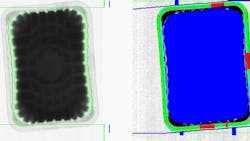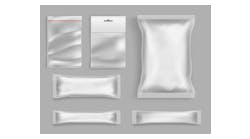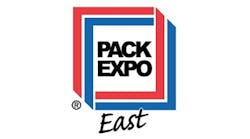The seal of approval — first time, every time
Food packaging has been in the spotlight recently, with Illinois-based CF Industries forced to temporarily shut two UK sites that produce 60% of the country’s carbon dioxide supplies — because of a sharp rise in gas prices. But a carbon dioxide shortage is not the only challenge facing food manufacturers.
Once the protective gas mix including carbon dioxide has reduced the amount of oxygen inside the food packaging, a good seal is crucial to help the contents stay fresh for as long as possible. If a salad leaf gets caught up in the seal and is left sticking out of a packaged pasta salad, for example, it will breach the airtight seal and allow in oxygen — which will make the product spoil faster and lead to wastage and customer complaints.
Traditionally, seal inspection solutions have involved a sniffer approach, to detect nitrogen or carbon dioxide, or a pressure system to check whether a product bounces back or deflates — if it deflates, it gets rejected. Another option is vision systems — but their accuracy is limited.
The latest X-ray technology, on the other hand, offers unrivaled accuracy. Two images are generated from a single detector — one optimized for the product and one for the seal area. It means even the tiniest speck of sauce trapped in the seal of a ready meal can be detected. And, unlike vision systems, X-ray seal inspection can cope with non-transparent packaging and items with pack colors that are all very similar.
One of the most ubiquitous methods of packaging incorporates sealing with a plastic or foil material. This can be in the form of flow-wrap packaging, form-fill-seal or thermoformed trays. In each case, there is a bond between one or more surfaces of a film material and a substrate, such as the lip of a tray.
The seal can become ineffective for various reasons. The two sides of the seal can simply not be bonded together, for example, resulting in a blown seal — or food matter can be trapped between the sealing surfaces, creating a non-sterile channel. Because of the importance of these failure modes, they are often mitigated by having operators located at the end of the production line to perform a visual inspection. That obviously represents a substantial expense and an operational burden, as the recruitment and training of staff is becoming increasingly difficult.
The first of these conditions can, in certain circumstances, be detected using either ultrasonics or pressure decay. In the case of ultrasonics, a transducer will emit a beam of sound waves directed at the seal. A detecting element will pick up the signals transmitted or reflected by the surfaces of the seal region. These reflections occur when there is a change in impedance, such as would occur in a material-to-air interface. If there is a good seal, there will be two interfaces which will produce reflections. However, if the seal is open, four reflections will be produced. There are, however, many inefficiencies due to impedance mismatches and the inability to use coupling fluids such as those used in medical ultrasonics — and, as a result, this technology has never gained traction.
Further, if there is food material trapped within the seal, the seal will appear good to ultrasonic inspection — but this will present a channel that will affect the sterility of the package. In many cases, the thickness of the trapped food material will be very small, as the pressure of the sealing head will cause it to extrude away from the sides of the seal.
In this scenario, the latest generation of X-ray technology can be an effective solution. By adjusting the X-ray energy to a suitably low level, it is possible to detect very thin layers of seal contamination. At this very low level, the resulting X-ray image data will be much reduced and subject to general signal fluctuations. The systematic nature of these fluctuations can be exploited to create a compensated image. An example of such a fluctuation would be the joint in a conveyor belt, which would generally appear as a somewhat denser region of the background. This can be factored out by a compensation algorithm. Then, by scanning along the seal for an incrementally different response, the technology can reliably detect organic material deposits as small as 50 microns thick.
There are also other clues to the presence of contamination, allowing hotspots in the seal region to be identified. For example, the presence of a strand of food adjacent to the seal region will indicate that material on the seal has been extruded away from the sealing surface. These hotspots trigger implementation of an algorithm to enhance the detectability of small seal defects.
Optical methods — such as machine vision cameras — are often used to detect the presence of extraneous material on a seal. But, unlike the new generation of X-ray technology, optical systems suffer from a series of limitations. Firstly, they often require that the seal surface is transparent in order to backlight the region being inspected, or that the lid stock is non-opaque. Secondly, the systems are subject to reflections and color differences in the image — and they are unable to inspect areas where there is a label superimposed on the seal.
Another major advantage offered by the latest X-ray technology is end-of-line inspection of the contents of packages for the traditional range of foreign bodies. A pack of ground beef, for example, will need to be inspected for metal and bone fragments. Traditionally, this has required two X-ray systems — one for the seal and one for the product inspection — as the product inspection requires the penetration of a considerable thickness of food material in the package. This has meant duplication of a significant amount of expensive hardware.
The new generation of X-ray technology, however, can produce two sets of output data simultaneously. The first output creates an image suitable for contaminant detection within the product, and also defines where the product is within the packaging. The second output uses this data to define the seal inspection zone, where it creates an image of much higher sensitivity.
Combining these two different types of inspection in a single unit means a simplified set-up and product changeover, as well as combined statistics and just one interface to factory information systems. And two further inspections can also be incorporated — weighing and label inspection. Weighing can be done either via an integrated weigh-table or through further analysis of the X-ray images, with the results used to check that the weigh-price-labeler has correctly labelled the pack.
The increasing use of skinpacks means the latest X-ray technology also has a crucial role to play in ensuring food products are in the center of their packaging — and that any leaching of liquid within the sealed area is detected. Pouches of meals ready to eat (MREs) provided to the military are also coming under the watchful eye of the latest X-ray vision. These individual rations, with a shelf life of up to two years, require retort pouches capable of withstanding cooking and freezing. But the latest sensor technology offers very high resolution to detect even very small seal defects.
With staff shortages threatening to hold back post-COVID-19 pandemic economic recovery around the world, the latest generation of X-ray inspection technology is set to provide a new vision of the future for the processing industry.
Dr. Richard Parmee is founder and CEO of X-ray inspection technology specialist Sapphire Inspection Systems. As well as designing bespoke solutions, Richard and his team provide a wide range of standard X-ray inspection systems to cater for hundreds of different products in the food, pharmaceutical and cosmetics industries.




